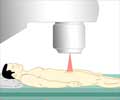Potential to rapidly assess experimental therapy outcomes and help develop personalized medicine for patients with prostate cancer is possible with a new model.

"The mathematical model we created simulates this vicious cycle, and allows us to predict the impact of potential therapies on cancer cells and normal cells of the bone," said Arturo Araujo, Ph.D., postdoctoral fellow in the Department of Integrated Mathematical Oncology at the Moffitt Cancer Center. "Unlike biological models, we can freeze the mathematical model at any time point in order to explore what each cell is doing at that particular point in time."
To create the computational model, which they call "hybrid cellular automata," Araujo, Cook, and colleagues created simulations of different cell types involved in bone metastasis of prostate cancer, including two types of bone cells called osteoclasts and osteoblasts, and prostate cancer cells. They then created algorithms to simulate the interactions of these cells among themselves and with other bone metastasis-related factors in the microenvironment, including the proteins TGF-beta, RANKL, and other bone-derived factors.
The researchers found that when they introduced a single metastatic prostate cancer cell to the model, it was able to simulate bone metastasis seven out of 25 times, accurately creating the vicious cycle. This phenomenon is difficult to reproduce using preclinical animal models, which is critical in determining the best time to apply therapies in order to obtain maximum efficiency, explained Araujo.
Further, the fact that the model failed to generate a bone lesion 18 out of 25 times reflects reality, where not every metastatic cancer cell that invades bone in prostate cancer patients succeeds in forming a viable lesion, he added.
In parallel to developing the computational model, the researchers grew prostate cancer cells that metastasize to bone in mice and found that the tumor growth rate predicted by the computational model was comparable to the tumor growth rate in mice, thus validating their simulations. The model was also able to identify some critical players and events in the process of bone metastasis.
Advertisement
With further improvements, the model can be individualized to determine personalized medicine for prostate cancer patients, Araujo noted.
Advertisement
Source-Eurekalert









![Prostate Specific Antigen [PSA] Prostate Specific Antigen [PSA]](https://www.medindia.net/images/common/patientinfo/120_100/prostate-specific-antigen.jpg)




